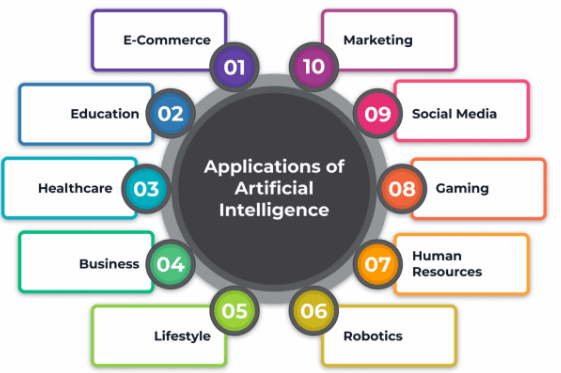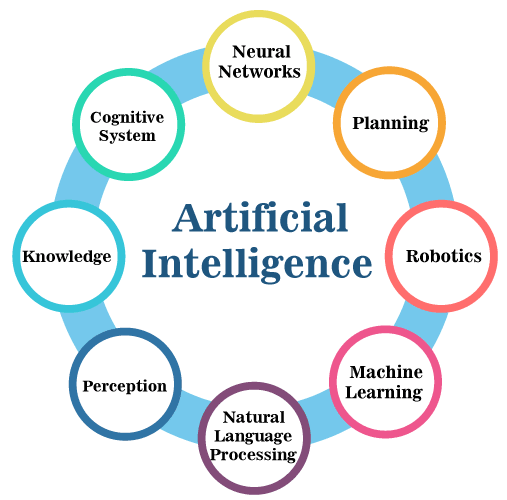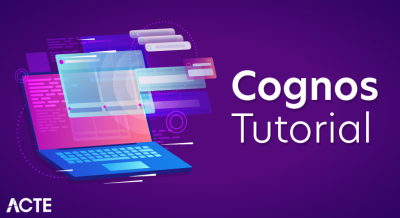
- What is Artificial Intelligence?
- Applications of Artificial Intelligence
- AI Basic Concepts
- What are artificial intelligence’s objectives?
- What is AI’s Future Technology?
- AI vs ML vs DL
- Popular AI Algorithms
- Ethical Considerations of AI
- Future Trends in AI
- Conclusion
Today, several uses of artificial intelligence are drawing us closer to the future of technology. Strong examples include autonomous vehicles, Google Translate, and Sophia, a humanoid robot. Additionally, have you ever pondered how Cyborg technology, which involves creating artificial body parts for individuals with disabilities to help them function normally, operates? If so, this introduction to Artificial Intelligence and Data Science will cover the fundamentals, starting from the basics.
What is Artificial Intelligence?
Artificial Intelligence, as the term implies, involves artificially imbuing machines with intelligence. It enables the development of devices capable of executing various functions and resolving actual issues without mistakes. AI enhances efficiency and output by automating mundane tasks. Moreover, it can generate engaging and interactive experiences and comprehend human feelings. This Artificial Intelligence guide will instruct you on all the AI methods that can be applied in practical scenarios.
Ready to earn your Artificial Intelligence Professional Certification? Discover the Artificial Intelligence Certification Course now available at ACTE!
Applications of Artificial Intelligence
- Self-driving vehicles: Tesla’s renowned autonomous cars serve as a prime example of how Artificial Intelligence is applied in the real world. These vehicles are equipped with advanced IoT sensors for recognizing images, detecting potential collisions, and monitoring surroundings, among other sophisticated features that enable them to operate safely and efficiently on the roads.
- Google Translate: Google Translate stands as another impressive use of Artificial Intelligence. It facilitates the translation of sentences from one language to another, and even translates entire web pages, thanks to its advanced capabilities.
- AI-powered signage: These signs, often found in smart cities and transportation centers, use artificial intelligence to provide tailored content based on real-time data such as events, traffic conditions, and weather.
- Amazon’s Alexa: Alexa features a voice recognition system that processes our spoken commands and returns the appropriate responses. It utilizes AVS (Alexa Voice Service), a service provided by Amazon, to accurately interpret and execute our requests.
- Google Maps: In today’s urban landscape, Google Maps is indispensable. It allows us to navigate from one location to another seamlessly. By simply entering our destination, Google Maps calculates the most efficient route for us to follow, showcasing the practical application of Artificial Intelligence in navigation.

What are artificial intelligence’s objectives?
Creativity and innovative thoughts are limitless, offering endless possibilities for creation, enhancement, and exploration. This principle applies to Artificial Intelligence as well, which continues to have vast potential for advancement and innovation. It’s akin to an infinite voyage, filled with numerous discoveries and developments, including the powerful programming language Julia that facilitates these innovations.
To summarize, the objectives of Artificial Intelligence include:
- Designing devices that mimic human intelligence
- Enhancing the performance and precision of machines
- Crafting instruments to assist individuals in addressing real-life challenges, such as robotics for those with disabilities, self-driving vehicles to prevent accidents due to human mistakes, and more.
- Machine Learning (ML): This subarea of AI concerns the creation of algorithms that allow computers to learn from data and make predictions based on it. Three primary techniques are ML supervised learning, unsupervised learning, and reinforcement learning.
- Deep Learning: An area of specialized Machine Learning k Means Clustering that employs deep neural networks having multiple layers to model complex patterns in large datasets. It is what spurred the breakthroughs in image and voice recognition.
- NLP: Is an AI subdomain that deals with the interaction between computers and humans in their natural language. The process enables machines to understand, interpret, and generate human language, supporting applications such as chatbots and translation services.
- Computer Vision: Is an AI field that allows machines to interpret and make sense of visual information. Applications include face recognition, object identification, and autonomous navigation.
- Robotics: Combine the AI with a physical robot, which may be able to function and carry out tasks autonomously or semi-autonomously to, for instance, perform manufacturing, healthcare, and service industries using AI-powered robots.
- Hyper Automation: By merging AI with robotic process automation (RPA), companies will automate increasingly complex processes across sectors like manufacturing, healthcare, and finance. Hyper Automation can eliminate repetitive manual tasks, boosting efficiency and cutting costs.
- Self-Operating Systems: The advancement of completely autonomous vehicles, drones, and robots will continue, making them more dependable and flexible for tasks like transportation, delivery, and emergency services.
- AI-Produced Content: Systems such as GPT and DALLE are improving to create high quality text, images, music, and videos, transforming the creative sectors. In the coming years, generative AI will support the creation of original art, design, and software code.
- AI for Drug Discovery and Design: Generative models will speed up research in pharmaceuticals by generating new molecules for drug discovery and testing.
- Clear AI Systems: As AI becomes more involved in making important decisions, the need for transparency will grow. Future AI systems will provide clearer explanations of their decisions and results, building trust in fields like healthcare, finance, and law.
- Reducing Bias and Ensuring Fairness: AI will be developed to recognize and reduce built in biases in algorithms, ensuring more just and equitable results, and addressing ethical and diversity issues in AI.
- Achieving Human-Level Intelligence: While present AI systems are specialized for specific tasks, the goal is to create AGI machines capable of performing any intellectual task a human can.
- AI Systems that Learn on Their Own: AI models will become increasingly self-learning, enhancing their capacity to adjust to new, unfamiliar situations without the need for human intervention.
- Customized Medicine: AI will enable highly personalized treatments, taking into account an individual’s genetic profile, lifestyle, and surroundings, to optimize care and treatment strategies.
- AI-Enhanced Diagnostics: AI will improve the accuracy of diagnoses in areas like medical imaging, early disease detection, and predictive analytics, facilitating quicker and more precise healthcare interventions.
- Linear Regression: This statistical approach is utilized to establish the connection between a dependent variable and one or more independent variables by creating a linear equation. It's extensively applied in predictive analysis.
- Logistic Regression: In contrast to linear regression, logistic regression is employed for classification tasks, especially when the outcome is dichotomous (0 or 1). It's frequently used in applications such as identifying spam and diagnosing diseases.
- Decision Trees: A supervised learning algorithm, decision trees are used for both classification and regression tasks. They represent decisions and their potential outcomes as a hierarchical structure, dividing data based on features.
- Random Forest: An ensemble learning technique, Random Forest constructs multiple decision trees and combines them to enhance accuracy and prevent overfitting. It's applicable to both classification and regression tasks.
- Support Vector Machines (SVM): A robust classification algorithm, SVM identifies the hyperplane that most effectively separates data points into different classes. It excels in handling high dimensional data.
- K-Nearest Neighbors (KNN): A straightforward and intuitive algorithm, KNN classifies a new data point based on the majority class among its k-nearest neighbors. It's utilized in pattern recognition and recommendation systems.
- Advancements in General AI: Still in the research phase, potential progress toward General AI, which could allow machines to do much more with human-like intelligence, will present opportunities and raise quite serious ethical dilemmas.
- AI and the Internet of Things (IoT): Infusing AI with IoT devices will enable smarter environments, with devices interacting and making autonomous decisions. This change relates to smart homes, cities, and industries.
- Explainable AI: As people’s need for transparency in AI grows, explainable AI research focuses on developing models that provide understandable rationales for their decisions, fostering trust and accountability. Tools like Spark SQL can be utilized to analyze data effectively, ensuring that the reasoning behind AI decisions is clear and accessible.
- Human-AI Collaboration: In the future, we will observe more collaboration between humans and AI systems. In this context, AI will enhance human abilities to make better decisions and solve problems in different fields.
- Regulatory Frameworks: In the case of AI advancement, regulatory frameworks will become one of the most critical policies. Governments and organizations have recently undertaken the job of setting basic guidelines for what it means for AI development and deployment in an ethical manner.
AI Basic Concepts
Get Your Artificial Intelligence Certification by Learning from Industry-Leading Experts and Advancing Your Career with ACTE’s Artificial Intelligence Certification Course.
What is AI’s Future Technology?
1. AI-Driven Automation
2. Generative AI
3. Explainable and Ethical AI
4. Artificial General Intelligence (AGI)
5. AI in Healthcare
Want to Master Artificial Intelligence? Explore the Artificial Intelligence Master Program Offered at ACTE Today!
AI vs ML vs DL
The most frequent question is about the difference between AI, ML, and DL. In short, machine learning is a component of Artificial Intelligence, and deep learning is a subset of machine learning. As a result, artificial intelligence functions as a more comprehensive category, encompassing both Machine Learning and Deep Learning.
| Artificial Intelligence | Machine Learning | Deep Learning |
|---|---|---|
| Artificial Intelligence encompasses a collection of methods and procedures through which machines can mimic human actions. | Machine Learning and Deep Learning are employed in the creation of AI systems. Machine Learning is a branch of AI that deals with the analysis of vast data sets and forecasting upcoming occurrences. | Deep Learning, on the other hand, employs neural networks, which consist of numerous nodes or artificial neurons attempting to address issues in a manner akin to biological neurons. |
| Artificial Intelligence mimics human actions and tackles issues such as missionaries and cannibals, the Bayes theorem, finding the shortest route, and more. | Machine Learning draws from symbolic methods in AI and employs models, statistical analysis, and theories of probability to make decisions based on data. | Deep Learning offers a layered abstraction, simplifying the process of training models by not relying on particular algorithms. |
| Artificial Intelligence needs advanced computing equipment to mimic the intended results. | Machine Learning can operate on less extensive data sets, thus minimizing the necessity for top-of-the-line graphics and computer hardware. | Deep Learning demands superior technology since the effectiveness of the models is greatly influenced by the volume of data provided. |
| Artificial Intelligence requires a significant amount of time to educate a system and ensure it’s proficient enough to deliver flawless outcomes. | Machine Learning, on the other hand, is quicker to train, typically ranging from a couple of hours to a full day. | Deep Learning models are more time-consuming than those in Machine Learning because they must account for numerous parameters. |
Popular AI Algorithms

Ethical Considerations of AI
The importance of ethics in AI techniques grows with the advancing sophistication of AI technology. Bias and fairness in AI programs can inadvertently perpetuate various biases present in the training data, leading to unfair treatment of certain groups. AI algorithms must ensure fairness to prevent differential treatment in applications such as hiring, lending, and law enforcement. Tools like R Programming can help analyze and mitigate these biases, promoting ethical AI practices. Privacy The huge amounts of personal data, typically in the form of feedback and learning processes, associated with AI raises grave concerns about privacy and data security for building trust in AI systems. Accountability issues make it very complex when errors or harm arise due to decisions made by an autonomous AI system. Is it liable and accountable? Job Displacement AI automatically replaces tasks in work and raises concerns regarding job displacement and the future of jobs. Even though AI can create new opportunities, it will also make others obsolete, meaning individuals must be retrained or upskilled. Many AI systems, particularly deep learning, worked as “black boxes,” making it difficult to understand the reasoning behind a specific decision. This indicates that AI systems need to evolve to become more transparent and interpretable while ensuring user trust and accountability.
All Set for an Artificial Intelligence Job Interview? Take a Look at Our Thorough Collection of Artificial Intelligence Interview Questions to Help You Prepare!
Future Trends in AI
Conclusion
Artificial Intelligence (AI) stands as a revolutionary area of Future technology, providing answers to intricate challenges across various sectors by imitating human intelligence through the use of algorithms and data-based models. AI is quickly progressing with its usage in healthcare, finance, manufacturing, and more, boosting productivity, decision-making, and automation. From the development of machine learning and neural networks to the application of natural language processing and reinforcement learning, AI algorithms are constantly improving, allowing machines to learn, adjust, and carry out tasks that were previously exclusive to humans.






